Romania 2023: Margaret's Travel Log
Continued from Margaret's Travel Log: Bulgaria
Updated 8 February 2024
Updated 8 February 2024
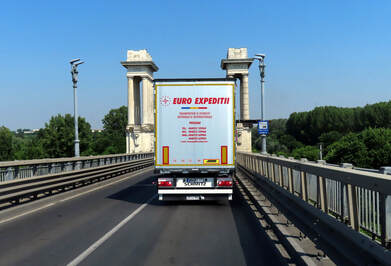
Koshov, Bulgaria to Camping Oude Wilg, Carta, Romania 249 miles
A 22-mile drive along the main road via Ivanovo to Ruse and the ironically-named Friendship Bridge over the Far-from-blue Danube, linking Bulgaria with Romania. Despite the rumours and long lines of waiting trucks, there was little delay for private vehicles. We filled with diesel and paid the bridge toll of €6 on the Bulgarian side and edged our way for 2.25 km across the bi-level road and rail bridge, built by Russia in 1952. On the far side we bought a 7-day Romanian vignette for €8
A 22-mile drive along the main road via Ivanovo to Ruse and the ironically-named Friendship Bridge over the Far-from-blue Danube, linking Bulgaria with Romania. Despite the rumours and long lines of waiting trucks, there was little delay for private vehicles. We filled with diesel and paid the bridge toll of €6 on the Bulgarian side and edged our way for 2.25 km across the bi-level road and rail bridge, built by Russia in 1952. On the far side we bought a 7-day Romanian vignette for €8
 On entering Romania Paddington, once intended for Orphans in 1990, takes cover in his bed
On entering Romania Paddington, once intended for Orphans in 1990, takes cover in his bed
A new TIR route past Giurgiu soon joined the E85 dual carriageway towards Bucharest. After weeks of deciphering Slavic Bulgarian in Cyrillic script, it was good to see signs we could easily read and perhaps understand, the Romanian language being Latin-based (eg paine for bread). We passed two busy Sunday markets with roadside stalls selling fruit and live chickens before joining the busy Centura ring road at 60 miles. Another 10 miles towards Pitesti, then onto the A1, a 4-lane motorway ending at that industrial city. We broke for lunch on a service station by Pitesti at 133 miles, then took the E81 signed Rimnicu Valcea/Sibiu.
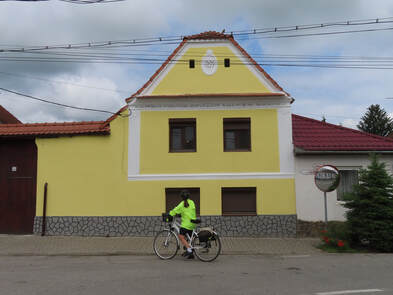
The narrow road climbed and twisted up to 540 m at Moraresti, dropped to 350 m, then rose to 450 m and down again to 225 m at Rimnicu Valcea where heavy rain fell, in the foothills of the southern Carpathians. Here we crossed the Olt River, then closely followed its river valley alongside the railway towards Sibiu. There were many new hotels, restaurants and truck stops along the scenic route. Meeting the busy road 1 we turned right towards Brasov, then (2 km past the Transfagaras Route roundabout) took a left turn for the village of Carta, the Fagaras Mountains looming snow-flecked above.
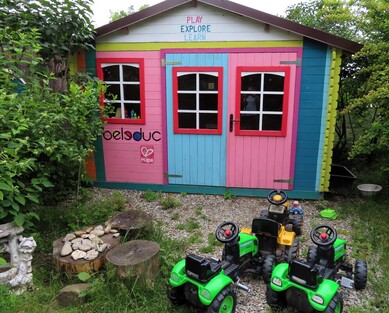
Along the lane, over the railway line and left in the village to the delightful Old Willowtree (Oude Wilg) campsite, tucked behind the house of its owners, our old friends Manette and Tudor. Manette (who is Dutch) welcomed us warmly and her Romanian husband, a gentle artist, is looking forward to the day he can retire from teaching at the village school. We recommended it! Manette was helpful as ever, changing Euros for Romanian Lei and offering a wash & dry laundry service.
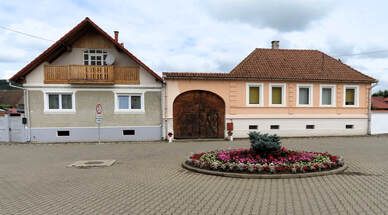
At Camping Oude Wilg, Carta, Romania
As the weather turned wet for two days, we were content to settle in, walk to the village shop and catch up with writing. Also worked out a schedule for returning to the UK. Bulgaria and Romania are still outside the Schengen area (until March 2024) but once we enter Hungary the countdown begins, with just 9 days left to get back! We duly booked a Stena Line ferry from Hook of Holland to Harwich in a fortnight’s time, though it all felt somewhat remote.
As the weather turned wet for two days, we were content to settle in, walk to the village shop and catch up with writing. Also worked out a schedule for returning to the UK. Bulgaria and Romania are still outside the Schengen area (until March 2024) but once we enter Hungary the countdown begins, with just 9 days left to get back! We duly booked a Stena Line ferry from Hook of Holland to Harwich in a fortnight’s time, though it all felt somewhat remote.
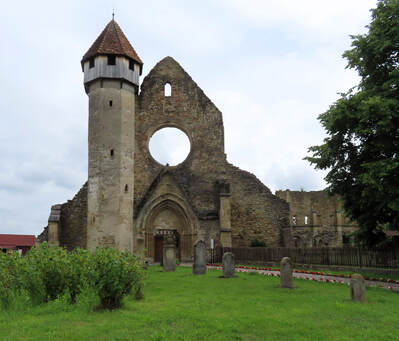
Cycling 43 km, turned back by Bears!
When the rain cleared we cycled round Carta and past the ruins of the Cistercian Abbey, with a small entrance fee and café, which we’ve explored before. The village looked quite prosperous, with new paving throughout and most of the houses nicely painted. Tudor’s school next to the church was open and the park, which we remember for the annual Saxon Feast around the Maypole, was very neat and full of flowers.
When the rain cleared we cycled round Carta and past the ruins of the Cistercian Abbey, with a small entrance fee and café, which we’ve explored before. The village looked quite prosperous, with new paving throughout and most of the houses nicely painted. Tudor’s school next to the church was open and the park, which we remember for the annual Saxon Feast around the Maypole, was very neat and full of flowers.
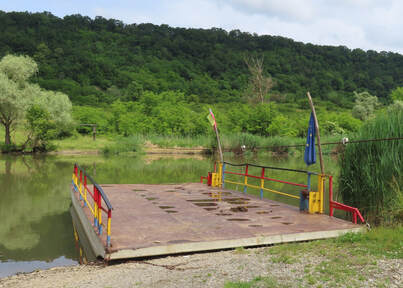
We rode down to the river, where the old chain ferry barge we once used is still moored though no longer in service. From there a rough track, past a gipsy sheep farm and an old rusty mine of some sort, leads to meet the main Brasov-Sibiu highway by the roundabout at the foot of the Transfagaras route. Here we had coffee at a smart new hotel, next to a tourist shop selling wicker baskets and woven cloths.
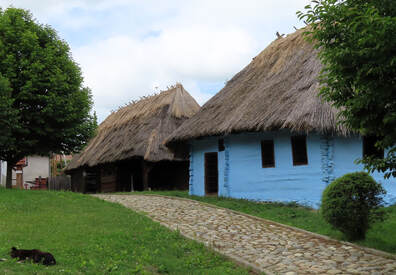
Over the busy highway, then a quieter road south for 4 km to the elongated village of Cartisoara, with a few guesthouses, a shop, church, war memorial and interesting folk museum where we once watched a weaving demonstration. An old chap proudly spoke a little English, telling us his daughter worked in Manchester and had just flown back to Sibiu for a visit! We continued south on road 7C, climbing gently from 400 m to 670 m at the beginning of a series of hairpin bends which lead to the Balea Cascade (10 km further) and on across the famous Transfagaras Highway. This serpentine route was built by the infamous dictator Ceausescu, not for the amusement of the Top Gear team or the summer tourists but as a quick military access across the mountains in case of a Soviet invasion, at a huge cost and the loss of several hundred lives.
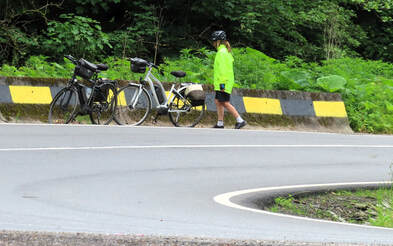
As we paused at the first hairpin to ponder how much further to ride, a descending motorist stopped to warn us that he’d just spotted a bear in the roadside forest (and it wasn't Paddington)! An easy decision to freewheel down to Cartisoara, from where we circled back via cold drinks in the village of Arpasu de Jos, then a rough track alongside the river and past the Abbey into Carta.
Carta to Camping Aurel Vlaicu, Aurel Vlaicu, Romania 109 miles
The Carpathians had again disappeared in a mist of rain as we left Oude Wilg with Manette’s traditional farewell Drum Bun (= Road Good), an interesting mixture of Greek Dromos and Latin Bonum.
Heading west, we checked out a small Lidl store in Avrig with no parking space, so continued on road DN1 to a new commercial centre on the outskirts of Sibiu. Ample room to park in front of Auchan, Carrefour, Decathlon and other stores on the left of the dual carriageway (but not at Lidl on the right). So we stocked up at Carrefour, including a roast chicken and delicious pȃtisserie, and ate lunch on the car park. Romania has changed since we first came by bicycle in the summer of 1989, abruptly leaving because we couldn’t find any food on sale, while the people survived by self-sufficiency and barter.
The Carpathians had again disappeared in a mist of rain as we left Oude Wilg with Manette’s traditional farewell Drum Bun (= Road Good), an interesting mixture of Greek Dromos and Latin Bonum.
Heading west, we checked out a small Lidl store in Avrig with no parking space, so continued on road DN1 to a new commercial centre on the outskirts of Sibiu. Ample room to park in front of Auchan, Carrefour, Decathlon and other stores on the left of the dual carriageway (but not at Lidl on the right). So we stocked up at Carrefour, including a roast chicken and delicious pȃtisserie, and ate lunch on the car park. Romania has changed since we first came by bicycle in the summer of 1989, abruptly leaving because we couldn’t find any food on sale, while the people survived by self-sufficiency and barter.
Another surprise was the brand-new motorway A1, leading all the way from Sibiu to the Hungarian border at Nadlac. We took this as far as the exit for Sebes, crossed the A1 and doubled back onto the old main road number 1, turning off a couple of miles later for Girbova Village. Our aim was the Christian holiday complex and campsite Poarta Oilor (= Gate of Sheep) of which we had happy memories. Despite the email reply to our enquiry, saying that the site was open and we were welcome, it proved impossible to access the gates unless you were a sheep, as the short side road was being dug up, with heavy machinery in a sea of mud and workmen waving us away. And no answer from the campsite’s phone: not very Christian!
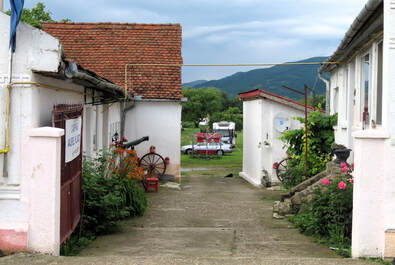
So it was back to the A1 westbound, past Sebes, past the junction with A10 (a new motorway going north to Turda and Cluj), to the exit for the village of Aurel Vlaicu. The small campsite is tucked away behind the owner’s house, accessed via two narrow archways. The camp warden, Peter from Stuttgart, helped us inch our way through the gap, cab mirrors folded back, and we settled in for a good dinner of roast chicken and chocolate cake, thanks to Carrefour. The French do get some things right!
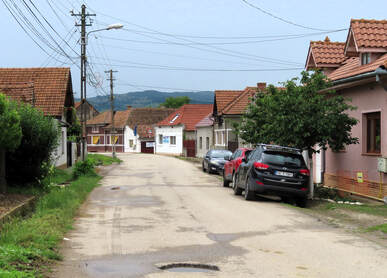
At Camping Aurel Vlaicu, Aurel Vlaicu, Romania
Rainy again, so a short walk round the typical farming village, once called Bintinti. It was renamed Aurel Vlaicu in honour of its famous son, a pioneer aviator and developer of aeroplanes, born here in 1882. He died in a plane crash in September 1913 and was commemorated on the old 50 lei bank note. Along the main street we found his statue outside the Aurel Vlaicu Museum (closed), as well as a school next to the church and graveyard, though our hero is buried in Bucharest.
Rainy again, so a short walk round the typical farming village, once called Bintinti. It was renamed Aurel Vlaicu in honour of its famous son, a pioneer aviator and developer of aeroplanes, born here in 1882. He died in a plane crash in September 1913 and was commemorated on the old 50 lei bank note. Along the main street we found his statue outside the Aurel Vlaicu Museum (closed), as well as a school next to the church and graveyard, though our hero is buried in Bucharest.
Aurel Vlaicu to Camping Route Romanie, Minis, Romania 106 miles
Heavy rain as we drove 1.5 miles back through the village to the A1 westbound. After passing Deva we took the exit at Sacamas onto rd 7, the old main road to Arad. (The A1 continued to Timisoara and the Hungarian border but would have missed our destination at Minis.) At 72 miles we had a lunch break in the village of Nicolae Balcesku, watching two cows being herded along a track that tunnelled under the road. We continued through the valley of the River Mures, alongside the railway, until the village of Paulis where we turned right for 2 miles to Minis, its campsite signed down a lane on the left.
Heavy rain as we drove 1.5 miles back through the village to the A1 westbound. After passing Deva we took the exit at Sacamas onto rd 7, the old main road to Arad. (The A1 continued to Timisoara and the Hungarian border but would have missed our destination at Minis.) At 72 miles we had a lunch break in the village of Nicolae Balcesku, watching two cows being herded along a track that tunnelled under the road. We continued through the valley of the River Mures, alongside the railway, until the village of Paulis where we turned right for 2 miles to Minis, its campsite signed down a lane on the left.
We were greeted by Cornelius, the Romanian founder of the camping, and his Dutch wife Anna. Now living in the Netherlands, they were here visiting son Paul, who runs the site. We soon learnt that they are Baptists and that Anna first came to Romania in 1990 with a Christian group to help street children. And so she met Cornelius, who bears a striking resemblance to Albert Einstein! They still provide holidays at the camp for poor children and orphans.
Of course we talked at some length about our own three missions to Romania in 1990, greatly helped by the network of Baptists around Arad. It turned out that our hosts knew our old contacts, Pastor John and Mimi, who now run a children’s home. They also remembered the orphanage in the nearby town of Siria – one of many to which we delivered aid, following the fall and execution of the Ceausescus at Christmas 1989.
Settling in, we made use of the campsite wash & dry laundry and ordered dinner for 7 pm. Anna caters for guests in a small dining room, where we enjoyed Hungarian-style pork goulash with salad and potatoes, tiramisu pudding and a glass of wine for 12.50 Euros each.
Settling in, we made use of the campsite wash & dry laundry and ordered dinner for 7 pm. Anna caters for guests in a small dining room, where we enjoyed Hungarian-style pork goulash with salad and potatoes, tiramisu pudding and a glass of wine for 12.50 Euros each.
At Camping Route Romanie, Minis: Cycling 41 km to Siria
Dry at last and warmer, the temperature rising to 30°C. We took a leisurely Sunday morning ride for 16 km to Siria, where the cafes and most of the shops were closed, so we had to resort to ham & cheese croissants from a small Carrefour, eaten in the children’s playground. Cycling round the town, avoiding the only bar open (in the gypsy quarter), we recognised the former orphanage building, now a nicely restored school. We did find ice cream at a van in the market place, where a lone stallholder sat by a mountain of watermelons and cabbages.
Dry at last and warmer, the temperature rising to 30°C. We took a leisurely Sunday morning ride for 16 km to Siria, where the cafes and most of the shops were closed, so we had to resort to ham & cheese croissants from a small Carrefour, eaten in the children’s playground. Cycling round the town, avoiding the only bar open (in the gypsy quarter), we recognised the former orphanage building, now a nicely restored school. We did find ice cream at a van in the market place, where a lone stallholder sat by a mountain of watermelons and cabbages.
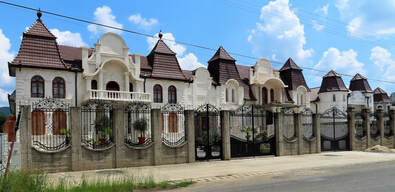
.On the return ride we paused half-way to photograph Covasant, a long village lined with dozens of extremely elaborate houses, quite out of keeping with the area, seemingly unoccupied, with some of them still half-built. They looked much too new to be a remnant of ‘The Party’. In the next village, spotting a shady bus shelter, we took a break. A passing couple, who kindly stopped to ask if we were OK, turned out to be lecturers at Arad University: she teaching English, her husband History! Also Baptists, they knew two more of our old contacts from Arad, Pastor John’s friends Dan and Cristina Fizedean. “We go to the same church” they said, promising to pass on our greetings.
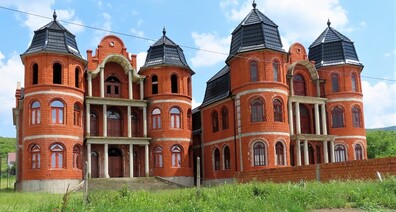
A second surprise was their answer to our question about the ‘gin-palaces’ at Covasant – built for show (not for occupation) by rich gypsies!! Back at the campsite, Cornelius confirmed this astonishing explanation, claiming that the gypsies made their money in England and splurged it on what he called Pagodas, each trying to outdo the other, while living in the original small house on the same plot.
Here are 10 pictures of the Amazing Gypsy Mansions!
Here are 10 pictures of the Amazing Gypsy Mansions!
Minis, Romania to Camping Topart, Gyor, Hungary 269 miles
Towards Arad on the busy rd 7, alongside tram lines and a bike path, circling several roundabouts where a new trunk road is still under construction. After 30 miles we were able to join the A1 motorway for 19 faster miles to the Romanian/Hungarian border at Nadlac/Nagylak. Here we would re-enter the Schengen Area, with 9 days left to reach the UK. At least the clocks went back one hour, giving us a fraction longer! There were the usual long lines of trucks waiting for customs checks but we had only a short queue. With our passports duly stamped at two adjacent windows, we entered Hungary and bought a Category Two 10-day (minimum) vignette for €29.
A fine new motorway took us past Szeged, joining the M5 at 86 miles towards Budapest. After lunch at modern service station at 145 miles, it was another 28 miles to the busier MO-Ring which crossed the Danube from Pest to Buda. At 190 miles we exited onto the even busier M1 for Gyor, heading northwest past Tatabanya and Tata. There were long delays before Tata, with dozens of trucks including 3 Swedish racing car transporters, while eastbound traffic flowed nicely.
Taking the third exit for Gyor at 265 miles, the SatNav led us back towards the city, then left for the signed campsite. It was an excellent find, with well-equipped kitchen and German-speaking Reception. Nice to see a cycle-touring Dutch family arrive and pitch their tents, with two young children on their own bikes and Dad towing a trailer.
Continued at Margaret's Travel Log: Return to the UK
Towards Arad on the busy rd 7, alongside tram lines and a bike path, circling several roundabouts where a new trunk road is still under construction. After 30 miles we were able to join the A1 motorway for 19 faster miles to the Romanian/Hungarian border at Nadlac/Nagylak. Here we would re-enter the Schengen Area, with 9 days left to reach the UK. At least the clocks went back one hour, giving us a fraction longer! There were the usual long lines of trucks waiting for customs checks but we had only a short queue. With our passports duly stamped at two adjacent windows, we entered Hungary and bought a Category Two 10-day (minimum) vignette for €29.
A fine new motorway took us past Szeged, joining the M5 at 86 miles towards Budapest. After lunch at modern service station at 145 miles, it was another 28 miles to the busier MO-Ring which crossed the Danube from Pest to Buda. At 190 miles we exited onto the even busier M1 for Gyor, heading northwest past Tatabanya and Tata. There were long delays before Tata, with dozens of trucks including 3 Swedish racing car transporters, while eastbound traffic flowed nicely.
Taking the third exit for Gyor at 265 miles, the SatNav led us back towards the city, then left for the signed campsite. It was an excellent find, with well-equipped kitchen and German-speaking Reception. Nice to see a cycle-touring Dutch family arrive and pitch their tents, with two young children on their own bikes and Dad towing a trailer.
Continued at Margaret's Travel Log: Return to the UK